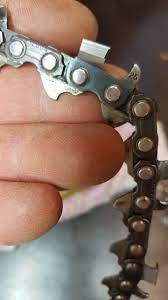It is usual for chainsaw chains to get longer and stretch during use. If you are a regular chainsaw user, you understand how critical it is to maintain the correct tension for your chainsaw chain. Loose chains sag off the guide bar and will keep falling off the saw, creating a hazardous situation for you.
What causes stretching in chains?
- Break-in period

A lot of chain stretching happens at this time when the chain is new, and you have just begun using it. As you run the chain towards one direction, the riveting play will be dragging in one way, causing an elongation on your chain loop.
This initial stretching happens in one hour or less of using it. That now explains why you must monitor a new chain to adjust its tension appropriately.
Thermal expansion
There is always intense heat build-up due to too much friction and pressure during use. However, with proper chain lubrication, good bar maintenance, and an unworn sprocket, stretching should not be that much to make a difference.
Running a chain without lubrication even for 2 minutes will lead to intense heating that can spoil the chain and the bar as well. If the chain overheats, wait until it cools down to tighten it. When it is still hot, contraction will occur as it cools down and can severely damage your tool.
Long use
As a chain wears with use, the clearance near the rivets gets worse, and your chain continues to stretch with each use. Well, the stretch after every use can be small but steady.
You should not ignore any of these pointers. They are indicators that the chain is worn out and needs replacement.
- Difficulty to move the chain around the bar
- blunt teeth.
What are the signs that my chainsaw chain is stretched?
- Unusual grinding or rattling noise originating from chain drive
- Wearing of the sprocket teeth.
- Timing belts show some variation in timing
- When you are using a tensioner, closely monitor to determine whether the needed degree of tension has scaled higher.
What is the correct chainsaw chain tension?

You need to know how a chain with proper tension looks and recognize when it needs tightening.
A chain with proper tension needs to be slightly loose on the guide but also tight that you can’t lift the driving links off the bar.
You will notice the drive links disengaging off the guide bar when you lift it for chains that need tensioning.
Avoid overtightening the chain. Leave some little play to ensure the drive links won’t leave the guide bar. Overtightening the chain risks breaking the chain during operation.
We also have explained how to shorten the chainsaw chains.
How can I tighten a loose chainsaw chain?
Tightening a chainsaw chain is super easy and should not take more than 2 minutes. However, you must follow the below steps correctly and with care.
Forgetting any step could lead to severe problems with your chainsaw.
Almost all chainsaws come with a screwdriver or wrench that complements the side plate nuts and the tension adjusting screw size.

Step 1
Ensure the chainsaw is turned off and cool. Never try tightening the chain when it is hot. The chain contracts as it cools down, and that could lead to an overtightened chain. You could also get burnt while working on a hot chainsaw. Be careful.
Step 2
Remember, chainsaws teeth are sharp and, if improperly handled, could lead to injuries. Place the chainsaw on a level and stable ground to safely carry out the process
Step 3
Start by loosening the nuts found on the saws guide bar side panel. That will provide room for the chain and guide bar to be tensioned.
If the chainsaw brakes are on the side panel, ensure you unfasten the brake before taking away the panel.
Step 4
Here you will need to fine-tune the tension Screw. The tension adjusting screw is found in different positions depending on the model you have. For example, it could be on the outer side of the bar between some two bolts or the inside board side.
The chainsaw may have an adjusting dial, meaning you will not need any tools for the process.
Once you tighten the screw, the chain will tighten while loosening it loosens the chain. Recheck to confirm the appropriate tightness before proceeding.
Step 5
Tighten up the side panel nuts on the guide bar.
Always lift the nose of the chainsaw as you tighten the nuts, which protect the guide bar and side panel.
Can I stop a chainsaw chain from stretching?
Chains tend to stretch to some level regardless of what you do. Therefore, always conduct a pre-operation assessment before use to determine whether you need to adjust it.
Is there any problem if I use a chain with improper tension?
Using a not well-tensioned chain will only cause damages to the chain and the tools guide bar.
It is also very risky as the chain may come off during operation, causing injuries. It is better to prevent than to regret.
Related Articles:
Check what are the best 24 inch chainsaw
Check the best 12-inch chainsaw reviews
When to replace the chainsaw bar? Explained
Last Updated on January 30, 2022 by John G. Anderson
Contents
